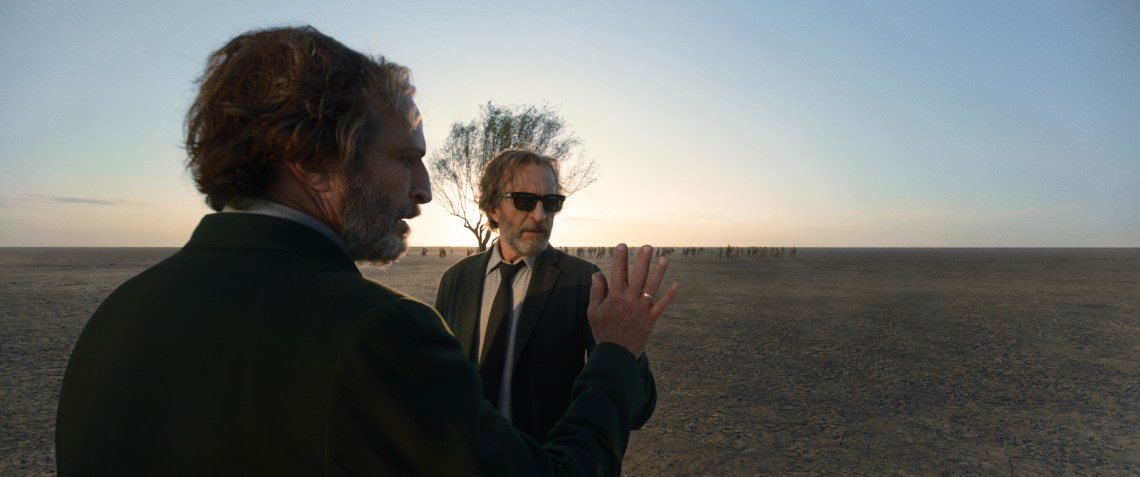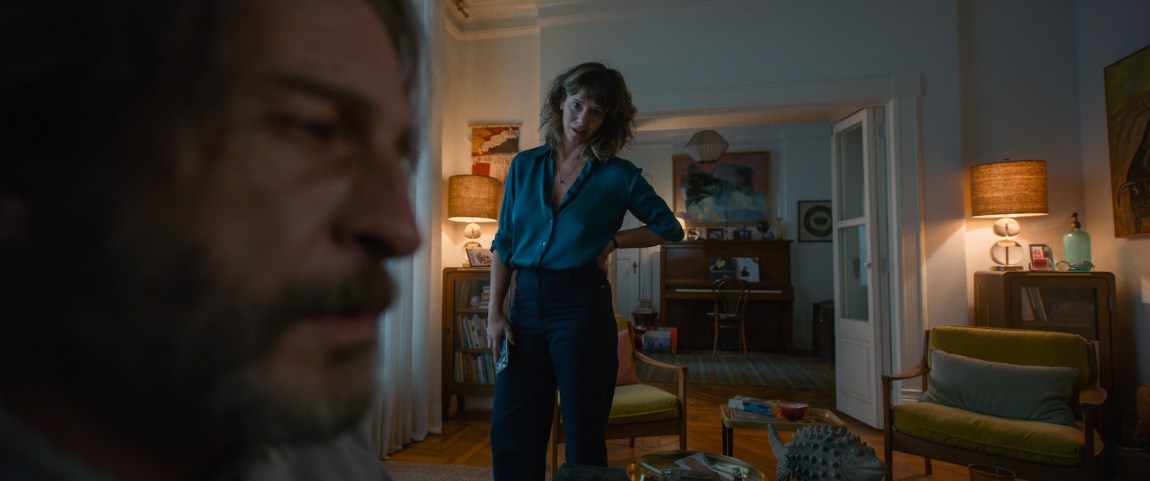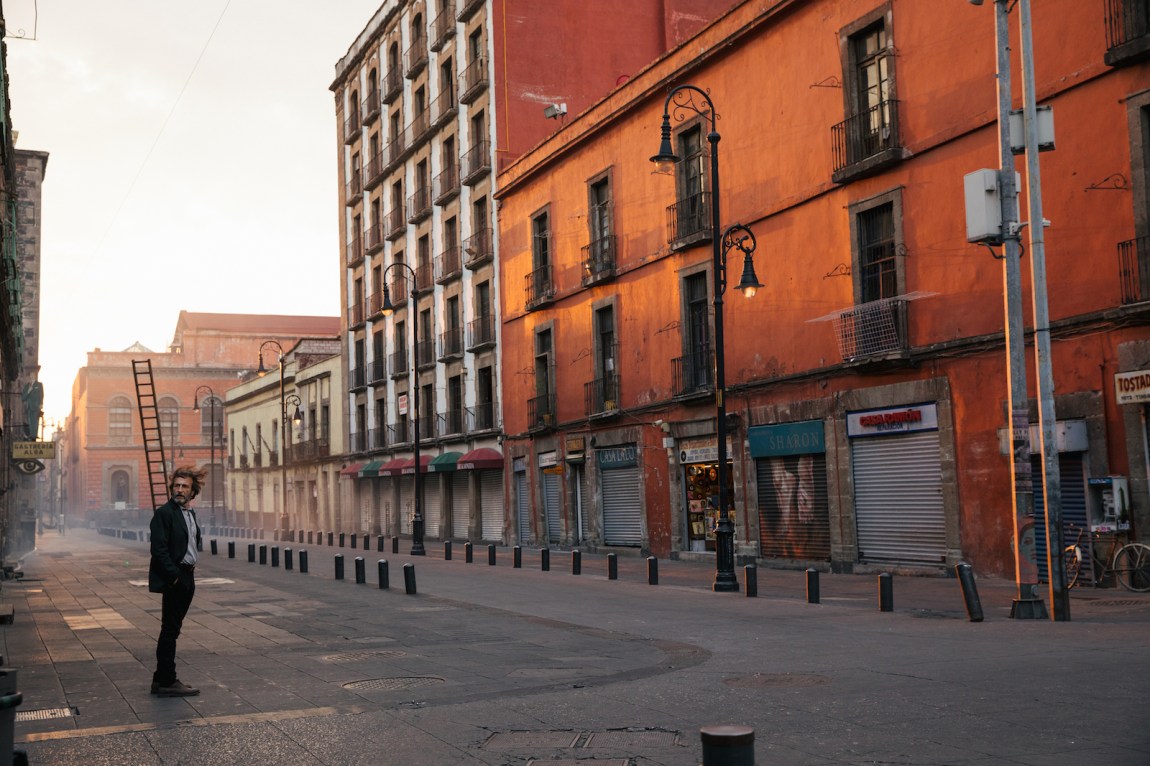When Alejandro González Iñárritu’s most recent film premiered last fall, he made a point of calling it not an autobiography but an “emography,” a representation not of his life but of his emotions. This was an understatement. Everything we see in Bardo, False Chronicle of a Handful of Truths occurs in the theater of the protagonist’s mind. Silverio, a US-based, US-celebrated Mexican filmmaker, is Iñárritu’s stand-in; he replicates his creator’s personal life and professional trajectory and gives voice to his desires and fears. Over more than two and a half hours, we witness Silverio’s life on both sides of the border: we go back to his childhood, forth to his death, and back again in a loop of anxiety and memory. But as Iñárritu has suggested, the film is driven less by narrative than by atmosphere, largely courtesy of Daniel Giménez Cacho, who plays Silverio, and Darius Khondji, the cinematographer whose grand visuals let Cacho’s talent shine.
Bardo is a Buddhist term for the intermediate state between the end of one life and the beginning of the next. This unhappy phase is no life itself—no real life, at any rate—and the film has a dreamlike quality. It opens with a wink at Fellini’s 8 ½, another dreamlike film about a self-mythologizing filmmaker: we see ourselves, from Silverio’s perspective, running in a desert landscape, then jumping so high we fly. But where Fellini’s images are tightly arranged to suggest the filmmaker’s moment of revelation about his womanizing and his pursuit of pleasure, Iñárritu’s are, in Silverio’s own words, haphazardly “knotted together.” Early scenes both foreshadow and return to haunt later ones. Small, soft-bodied creatures suggestive of regeneration and rebirth are a motif: axolotls, babies, children. There is an endless umbilical cord. Overflow is everywhere—of water in a flooded train; of sand in an apartment stranded in the desert; of people, from migrant masses to crowds of partygoers and extras on a film set. And there are ghosts: Silverio’s first son died in infancy, and Silverio’s father, a towering figure, counsels him from beyond the grave.
The source of the director’s anxieties is clear. Silverio is alienated both from the milieu he’s inhabited since he found success and from the one he left behind to get there. He deplores the toxic, obsequious Mexican entertainment industry but remains drawn to it. When he visits his old TV network for an interview with a onetime rival, the questions at once sicken and intimidate him. These fraught feelings extend to the culture at large. He approves of the venue for a party in his honor—a picturesque, run-down dance hall from the 1950s in an unglamorous part of Mexico City—yet shuts down everyone who tries to talk to him there. He goes up to the rooftop and has an argument, then takes refuge in the restroom downstairs. Instead of enjoying the salsa and cumbia, he plays David Bowie’s “Let’s Dance” in his head—one of the few moments in the film in which he appears content, away from all that Mexican color.
He is likewise ill at ease at the upscale resort where he is neither a foreigner, like the other guests, nor a local, and in the apartment he shares with his wife, which reminds them of their painful loss. Wouldn’t he like to return north and stay? But he does not belong there either, as a customs officer takes pains to inform him. “You have an O-1 visa,” he tells Silverio, without looking up from his computer screen. “This is not your home.” Silverio is quick to lose his temper, exposing his insecurities. Mexico is the backward, uncivilized world he has outgrown; America is the place an accomplished man deserves. But despite his sense of entitlement, he will never have the right his Los Angeles neighbors enjoy, the right to call America—or anywhere—home.
*
In the months since Bardo appeared, critics have taken issue with Silverio’s preoccupation with himself. (“Narcissistic,” “masturbatory,” and “pretentious” are some common words.) More striking is his resemblance to a character Cacho played six years ago in Zama (2017), the Argentine director Lucrecia Martel’s adaptation of Antonio di Benedetto’s 1956 novel. Don Diego de Zama is a criollo official of the Spanish Crown assigned by a new colonial administration to serve on an outpost in eighteenth-century Río de la Plata. As in Bardo, we find our hero placed provisionally and uncomfortably in what seems to him like a backwater. He is insecure and rootless, alienated by what he considers the misery of the new world: the poverty, the untamed wilderness, his mismatch with the other locals. He feels entitled to the social and legal privileges denied him. He waits exasperatedly for the letter that will grant his return to cosmopolitan Buenos Aires—or better yet to Europe—but he won’t work for it.
Advertisement
Bardo and Zama are both meditations on what leading a life without belonging can do to a mind already absorbed in itself. Esther Allen has pointed out in these pages that Cacho once confessed to Martel, perhaps because he was unsure about how to play the role, that he found Don Diego “a mediocre man.” What could be interesting, Cacho may have been wondering, about a character defined only by his surroundings—by the awkward position into which geography and power have forced him—and his discomfort with them? But part of the film’s strength is Don Diego’s role as a placeholder. He evokes the negative experience that marked the lives of colonial officials in the Americas and still marks those of bourgeois Latin Americans: the experience of being neither native nor European, neither oppressed nor oppressor, a learned man among the “savages” and an exotic one among the “civilized.”
We first see Don Diego standing like a captain in aristocratic dress—his hand on his sword’s hilt, a leg forward, looking boldly at the sea—and expect an army to follow him. But he is alone. Next we see him pathetically spying on a group of bathing women from behind a thin cover of grass. He is always somewhere wrong, always the odd one out: awkwardly trying to seduce his superior’s wife; moving uncomfortably among participants in an indigenous ceremony, trying not to touch them, eventually crawling among a sea of legs. This wrongness is the film’s subject. Don Diego’s ever-tense face is always at the center of the frame. Around him we see either the undifferentiated bodies of slaves and other indigenous people—their hands bathing him, serving him—or the faces of his superiors, his subordinates, and his lovers. But he seldom shares the foreground.
Silverio is lonely for different reasons. He is anything but mediocre. “The president knows you are an important voice in Latin America,” the American secretary of state tells him. He is “the first—that’s right—the first Mexican to receive the Alethea Award for journalistic ethics,” his old colleague says in an introduction, referring to the film’s version of the Oscars, at which Iñárritu has twice won for directing. More important for Iñárritu is that Silverio’s inner life is far from empty. Where Zama presents us with a cipher, in Bardo we are meant to get the sense of a uniquely complex mind. Both Silverio’s glory and his suffering are heroic. Every frame is a tableau, every shot deemed worthy of a dramatic wide angle.
The sonorous brass bands in the film’s parties, the cacophony of Mexico City’s soundscape (radio playing out of cars, street vendors shouting), even Silverio’s own breathing, which we hear when we walk in his shoes: Bardo’s audiovisual bombardment is almost overwhelmingly immersive. But the deeper the film plunges into Silverio’s experience, the more it becomes detached from the reality of his social and political world. What is it about Silverio’s context that makes him feel so alienated? The film gestures toward insights about migration and mobility, class relations within Mexican society, and the way in which those power structures affect how Mexican media is consumed and made. But its close identification with Silverio’s perspective means that it can only represent these forces superficially, not trace their implications. It can show Silverio recoiling from the kitsch of his old TV channel when he goes for the interview, for example, but not convey the association of talk shows and soap operas with the working classes (or the dissonance that someone who grew up watching them feels seeing them again as a grown member of the elite). It can depict Silverio following a wave of indigenous migrants when he’s making his own documentary film, but not the dark satisfaction Latin Americans sometimes feel when they see others who are worse off than them.
The morning of Silverio’s party, his son (Íker Sánchez Solano) confronts him over breakfast. The two men immerse themselves in an argument over Silverio’s use of immigrants’ stories in his work. “You shoot them, you interview them, you even make money with them, but you don’t know them at all,” his son insists. The accusation is that Silverio sees the migrants he films not as people but as ciphers on which to project his idea of a nation. “Every time we come to Mexico you try to convince me of how cool, deep, spiritual and cultural it is. But it’s not. People suffer and starve.” It is the most poignant line in the film, and Silverio has no answer to it.
Advertisement
Nor does he need one. Bardo is Silverio’s world; we just live in it. Yet the film’s choice to focus not on the questions his son raises but on subjects for which there are easily accessible cinematic metaphors—grief, loss, the blur between perception and reality—is a question of politics, too. Di Benedetto, a socialist, understood the usefulness of placing Don Diego’s life in the network of social relations that determine it, as did Martel. He also appreciated the absurdity of a single person fighting an entire social structure. Born in 1922, he refused to pander to the elitism of his country’s capital, where an aspiring writer had to relocate to make a name for himself. Instead he stayed in his hometown of Mendoza. A victim of the Videla dictatorship, he spent over a year in prison, where he was tortured, and upon his release he went into self-imposed exile. Martel grew up in a middle-class household with progressive politics in the country’s north, and in her first films she too turned an eye to the absurdities of the Argentinian bourgeoisie.
Iñárritu came of age in Mexico City’s middle class in the 1980s, an environment marked by “the search for growth and social mobility,” as the economists Luis de la Calle and Luis Rubio put it. He got his start in advertising, and as a director of commercials in the 1990s his creativity was put to work convincing television viewers across a largely undeveloped nation that it was important to buy nicer, newer things—imported things, after NAFTA was signed. (Since Iñárritu, many Mexican filmmakers have taken the same path.)
Where a novel like Di Benedetto’s or a film like Martel’s invites you to imagine what life is like for people in vastly different circumstances, a commercial wants you to see yourself at the center of the scene. “Picture yourself on this beach, drinking this beer.” In 2017 Iñárritu produced Cannes’s first ever virtual reality entry, an installation called Carne y Arena in which viewers wore headsets, plus some physical props, to place themselves in the middle of a group of migrants who cross the desert and face abuse by border patrol officers. Want to care about the powerless? Come, experience their suffering yourself! Bardo too minimizes the imaginative work required of the audience. Rather than encourage viewers to compare their own sources of nonbelonging with Silverio’s or urge them to connect Silverio’s nonbelonging with phenomena affecting others, it wants us to see ourselves in Iñárritu’s place.
The problem is not that this aesthetic is self-centered but that it doesn’t agree with the subject matter. Iñárritu’s immersive style works well in Birdman, or (The Unexpected Virtue of Ignorance) (2014), which pokes fun at the self-seriousness of actors; or in The Revenant (2015), a film mostly intended to give you the vicarious thrill of a bear attack. But to treat the anxiety of nonbelonging this way is to empty it out. Every scene in Bardo has to be in your face, every stylistic choice heavy-handed, every performance theatrical. “I spend my life convincing myself of the importance of what I do, of the value of recognition. But when it comes…the one thing I feel is that I don’t deserve it,” Silverio says to his wife, Lucía (Griselda Siciliani), without moving his lips (a motif that recurs to remind the audience they have privileged access to his thoughts). “Your imposter syndrome is pathetic,” she responds dramatically. “It’s craziness. You inevitably turn into what you think others think you are.” Lucía’s line is one among many we are meant to read as the film’s way of incorporating a critique of its self-absorption. But because everything we see in the film—including this line—occurs inside the filmmaker’s mind, even an attempt at self-critique becomes a form of navel-gazing.
*
To Cacho’s worry that his character in Zama was a mediocre man, Martel responded that “he did what he had to do.” This is both an indictment—the man had little agency—and an acknowledgment that he was just a cog in the wheels of history. We all are, but art thrives when artists are aware of it.
Zama and Bardo both conclude on the beach, a boundary between the safety of solid ground and the danger of losing it. In Zama, Don Diego tries to capture a local bandit, which he hopes will finally earn him his transfer. The bandit and his followers cut off Don Diego’s hands and tell him to bury his stumps in the sand to avoid bleeding to death. In Bardo, toward the end of their holiday, Silverio and his family walk into the water and spread the ashes of the child they lost many years before: Silverio lets go of at least one thing that anchored him. We see ourselves, from Lucía and Silverio’s perspective, gently grabbing that vulnerable old ghost. Instead of their child’s ashes the urn opens to reveal a miniature baby, his eyes closed, sucking his thumb. Then we see ourselves releasing it, watching it walk toward the sea, and getting lost in the water, as baby turtles do. The film ends, in other words, by advertising the promise of freedom. Be bold, face your traumas, let go of your past. This can be yours too.





